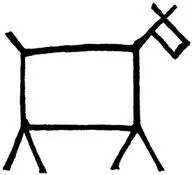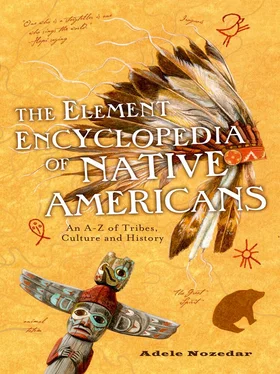When he was 25 or so, in 1768, Brant married a woman named Christine, whose father was an Oneidachief. The couple had met at school, and they had two wedding ceremonies: a Native American and an Anglican one. When Christine died just three years later, she left behind a daughter and a son. A couple of years after this, Joseph married Christine’s sister, Susannah, who also died shortly afterward of the same disease: tuberculosis.
In 1775 Brant was promoted to the rank of Captain and was dispatched to England; here he met King George III, and two dinners were held in his honor.
Once he returned to America, Brant led four of the Iroquois League Nations into attacks on the colonial outposts at the borders of the New York Frontier. During the War of Independence, the Iroquois League split in its allegiances. Two of the tribes favored the American case, while the others sided, with Brant, in favor of the British. Some of the tribal leaders preferred to remain neutral, hoping, no doubt, that the white men would all simply slaughter each other and turn their attentions away from the Native territories. Brant, however, argued against neutrality since he suspected that the Indians would lose all their lands if the colonists won the war and achieved independence.
Brant’s reputation as a formidable leader was cemented after an incident known as the Cherry Valley Massacre, in August 1778. Brant and his forces destroyed the town and fort at Cherry Valley in eastern New York. Some 30 men were killed, houses were burned to the ground, and 71 prisoners were captured. Subsequently, however, the British surrendered their lands to the colonists—and not to the Indians as they had promised.
A couple of years later Brant married his third wife, Catherine Croghan, who was the daughter of a Mohawk mother and an Irish father. Brant was now faced with having to find a new home, not just for himself and his new wife, but for the Mohawk tribes. During this time he also helped the new U.S. Commissioners make peace treaties with the Native peoples, regained his Army commission, and was awarded a tract of land for the Mohawk to settle on. This land was on the Grand River in Ontario. This territory—the Grand River Reservation—was established in 1784, and almost 2,000 Iroquois loyalists set up home there. All six tribes belonging to the Iroquois Nation were included, although the majority of the settlers were from the Mohawk and Cayugatribes.
The year 1785 saw Brant return once again to England, where he managed to secure compensation for Mohawk losses in the War of Independence. He had also wanted to gain a secure holding on the lands that had been granted the tribes, but was unable to do so.
Brant was a keen missionary, and in 1785 he oversaw the building of a small Protestant chapel on the reservation: Her Majesty’s Chapel of the Mohawks is a small wooden building which still stands today, and is the only place of worship with the title “Chapel Royal” outside the U.K. Brant believed that the Mohawk could learn a lot from the Christian faith, and encouraged white settlers onto Mohawk and Iroquois land, believing that the two races would learn from each other; this arrangement was unsettling for some. He also tried to arrange a proper land settlement between the Iroquois and the United States, and fought against further land cessions. He continued with his translations of the Bible up until his death in 1807 in Burlington, Ontario. He is buried at the Chapel of the Mohawks.

The word that used to be used to describe a young Native American male, “brave” was probably first applied by the Spanish explorers and settlers. In Spanish, bravo means wild and untamed, and the phrase Indios Bravos can be found in Spanish writings dating back to their time in the Americas. Whenever a Native American managed to overcome extraordinary hardship, he spoke of himself as having had a “brave time.”
A covering for the chest of male Native Americans, which was both protective and decorative, often made of long beads made of bone; traders called these beads “hair pipes.”
The breastplate was common to the Plains Indians.

Also called a breech clout, this was the material (often made of deerskin) that protected and covered the loins of a male Native. The breechcloth extended from front to back, looped over a piece of sinew tied at the waist with a length of cloth extending down at either side.
The original name of the Brule was Sichanghu , meaning “burned thighs.” The French word brulé means “burned.” The Brule were a division of the Lakota, who were one of the seven tribes of the SiouxConfederation. When the Lewis and Clark Expeditionencountered them in 1804, the tribe lived along both sides of the Missouri, Teton, and White Rivers. At the time they numbered about 300.
The chief at the time, Makozaza, was well-disposed toward the Europeans, unlike some members of the larger Lakota tribe.
A huntingtribe, the Brule chased the herds of buffalo; they were able to do this from horseback. The horseswere generally wild, and could be caught on the Platte and in Arkansas country.
When the white settlers and prospectors became a regular sight in Dakotacountry, it was the Brule who suffered the worst ravages of their diseases, which included smallpoxand measles, more than any other division of the Sioux. The reason was that the Brule lived closest to the route of the trail. The Treaty of Fort Laramie, signed in 1868, had a strong advocate in the Brule chief Swift Bear; the treaty was meant to restrict the incursions of the settlers but sadly did nothing to alter the course of events, and the settlers continued to flood into Dakota territory.
Although you would think that buckskin would be taken specifically from a male (buck) deer, this is not the case. Buckskin can be made from the hides of several animals, including the elk, the moose, the buffalo, and others.
Buckskin does not rely on tanning agents in the same way as leather does; rather, the rawhide is softened by being treated with smoke. The hair on the outside of the buckskin was sometimes left on, for added warmth and protection as well as beauty.
The process of making buckskin varied a little from tribe to tribe, but the basic technique was always the same. First, the skin needed to be softened; there were several methods of doing this. Sometimes the brains and gristle of an animal were rubbed into the rawhide to soften it; an alternative was to use mashed-up green maize, or eggs, or meal. After softening, the skin was beaten with a stone, stretched, and pummeled. At this point the buckskin would be ready to use: soft, white, and pliable. As such it could be fashioned into women’s dresses, pouches, and bags.
However, this skin, if wet, was liable to become stiff, and so a further process was added. After digging a hollow or pit in the ground, the skin was laid over an arched framework of sticks. A fire, using material such as rotted wood, corn chips, and chips of white cedar, was started in the pit. The buckskin was smoked for a couple of hours, taking on a color depending on the material that was used for the fire. Skins could also be dyed using natural substances: the tannins in oak bark produced an orangey red, whereas peach bark produced a bright red color.
Читать дальше














